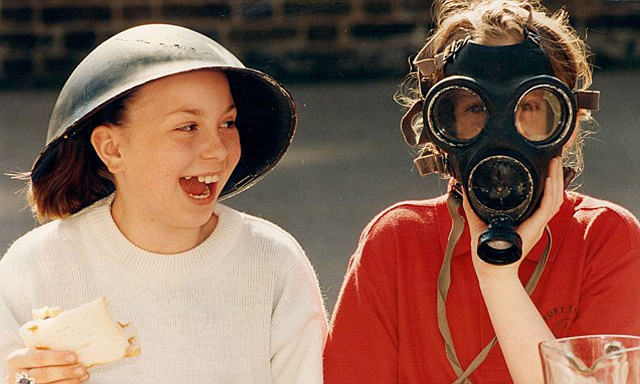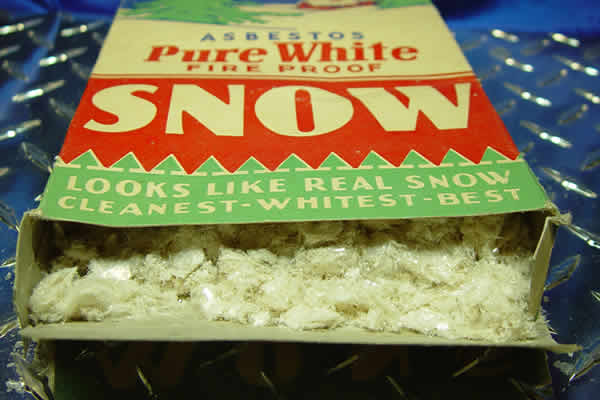
Asbestos has been around for many years and was used for lots of things before it was banned. Certain countries still use it today, even knowing the health risks.
Some of the historical uses of asbestos may shock you. Asbestos toothpaste, anyone?
To read about the history of asbestos first, click here.
Shocking uses of asbestos in the past
All of the items listed below have had a historical use of asbestos -
- Toothpaste
- Beauty products
- Fake snow
- Hair dryers
- Gas masks
- Surgical thread
- Cigarette filters
Now, let’s take a look at some of them in more detail.
Asbestos beauty products
It may shock you to think that people happily used beauty products such as make-up that contained asbestos. Even recently, asbestos traces have been found in make-up in November 2020.
But how does asbestos get mixed up with beauty products?
As asbestos and talc are both naturally occurring minerals, asbestos is found nearby talc when mined. Talc (talcum powder) is used in many products today.
Talc creates a soft texture in make-up products and can be found in eye shadows, blush, foundations, creams, and finishing powders.
Due to a lack of regulations in the production of cosmetic-grade talc, there are often traces of asbestos found that then gets used for beauty products. It’s not added purposely but it’s not tested often enough to avoid it completely.
There have been many cases in large brand products where asbestos traces have been found - Johnson’s being the most well known.
To avoid this, you can shop for talc-free products.
Asbestos toothpaste
Asbestos was used for toothpaste and made popular following World War 2. Why on earth was asbestos used in toothpaste?
The abrasive nature of the asbestos fibres meant that it cleaned your teeth very well!
Although it seems strange now, the risks were not known at the time.
Asbestos gas masks

During the Second World War, over 100 million gas masks for civilians were made containing asbestos fibres. They contained chrysotile and sometimes crocidolite asbestos fibres in their filters.
Asbestos was used as it was a readily available, cheap material that was strong.
Although the intention was to protect people from the gas bomb attacks, it’s now being said that more harm than protection may have been done. In the UK, thousands of people still die from asbestos-related diseases every year.
People who worked in the manufacturing factories and on the assembly line in the 1940’s have since reported asbestos-related illnesses. It was traced back that the exposure to fibres in the process of the gas masks caused this.

Fake snow asbestos
In the 1930-50’s, asbestos was used on film sets as fake snow. It was also used for Christmas decorations during this period.

The reason it was popular is the fluffy white substance did not catch fire unlike the other synthetics (asbestos is naturally fire-retardant).
A famous use of asbestos fake snow was on the set of “The Wizard of Oz”.

In the scene in the poppy field, the ‘snow’ was actually chrysotile, one of the worst forms of asbestos in terms of health dangers. Dorothy, the Scarecrow, the Tin Man, and the cowardly Lion were all exposed to high levels of asbestos.
It’s also reported the Scarecrow’s costume was flame-proofed with asbestos as he had some near run-ins with fire!
Asbestos cigarette filters
An American brand of cigarettes called Kent was launched in 1952, said to revolutionise the filter technique. Asbestos was used with crimped crepe paper to make cigarette filters.
These newly formed products were hailed as the first filtered cigarette and consumers bought them in mass. The popularity was down to the advertising focusing on the ‘positive health connotations’ the micronite (asbestos) filter brought.
They were produced in this way for 4 years before they changed the material to acetate. Even though it was a short period of time, there are people still filing lawsuits for damages to this day.
People filing against the company that made Kent cigarettes, Lorillard, were not only smokers of the cigarettes but also workers in their factories. Both were exposed to high levels of asbestos and have resulted in health implications.

Asbestos still used today
Unfortunately, asbestos has not been banned and is still used in some countries. India and China are among the top countries that still use tonnes of asbestos each year.
Other countries refusing to ban asbestos include - Kazakstan, Russia, Syria, Zimbabwe, and Belarus.
In America, asbestos was originally banned in 1973 but then overturned in 1991. There have been many political issues involving asbestos in the US and the material is still being used today. America no longer mines for asbestos but they do import it from other countries.
It’s unlikely that asbestos will be banned in these countries any time soon, despite the clear and proven health implications.
If you have any further questions about asbestos, please give us a call.






